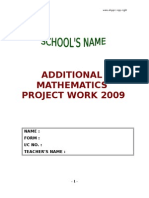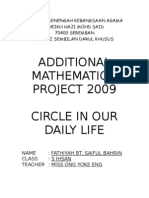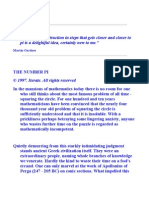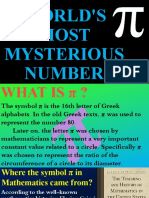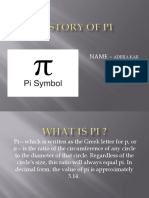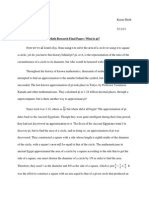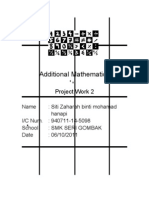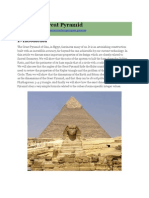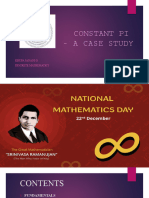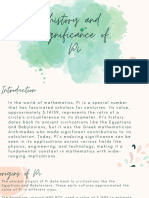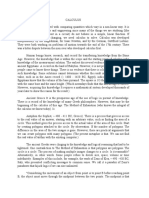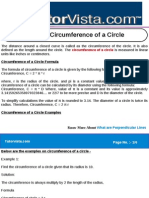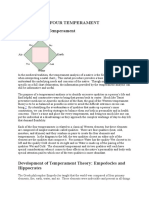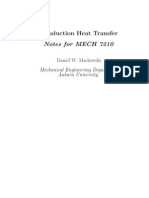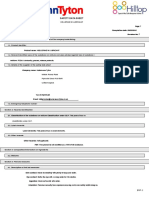Content
Content
Uploaded by
cangkulojenCopyright:
Available Formats
Content
Content
Uploaded by
cangkulojenCopyright
Available Formats
Share this document
Did you find this document useful?
Is this content inappropriate?
Copyright:
Available Formats
Content
Content
Uploaded by
cangkulojenCopyright:
Available Formats
CONTENT 1. ACKNOWLEDGEMENT 2. INTRODUCTION 3. PART 14. PART 2 5.
PART 3 ACKNOWLEDGEMENT First and foremost, I would like to thank god that finally, I had succeeded in finishing this project work.I would like to thank my beloved Additional Mathematic Teacher, Mrs. Wan Nurhalina bt. __________for all the assistanceshe has provided me during my job search. I appreciate the information and advice she have given, as well as the connections shehave shared with me. Her expertise and help have been invaluable during this process.Also, thanks to my mom and my dad for giving me fully support in completing this project work and permission to use their notebook for further research in completing this project work. I sincerely appreciate their generosity.I would like to give my special thank to my fellow friends who had given me extra information on the project work and studygroup that we had done. Thank you for spending time with me to discuss about the coursework.Last but not least, I would like to express my highest gratitude to all those who gave me the possibility to complete thiscoursework. I really appreciate all your helps. Again, thank you so much.Best Regards, INTRODUCTION A circle is a simpleshapeof Euclidean geometryconsisting of those points in aplanewhich are the samedistancefrom agiven point called thecentre. The common distance of the points of a circle from its centre is called itsradius.Circles are simple closedcurves which divide theplane into two regions, aninterior and an exterior. In everyday use theterm "circle" may be used interchangeably to refer to either the boundary of the figure (known as theperimeter ) or to the wholefigure including its interior, but in strict technical usage "circle" refers to the perimeter while the interior of the circle is called adisk.The circumference of a circle is the perimeter of the circle (especially when referring to its length).A circle is a special ellipsein which the twofociare coincident. Circles are conic sections attained when aright circular cone is intersected with a plane perpendicular to the axis of the cone. PART1 There are a lot of things are a lot of things around us related to circles or parts of a circle. Circle exists in our everyday lives andwithout circles, we could not imagine what it would cause to this world as the most important thing, the Earth itself is a circle. In thisproject, I will use the principle of circle that I had studied to design a garden to beautify the school. Before I further my task, first, we have to know what do pi () related to a circle.When referring to this constant, the symbol is always pronounced like "pie" inEnglish,which is the conventional Englishpronunciation of the Greek letter. In Greek, the name of this letter ispronounced/pi/.Pi or is a mathematical constant whose value is theratio of any circle's circumference to its diameter. In Euclidean plane geometry, is defined as theratio of acircle'scircumference to itsdiameter .The ratio C/d is constant, regardless of a circle's size. For example, if a circle has twice the diameter d of another circle itwill also have twice the circumference C, preserving the ratio C/d. Alternatively can be also defined as the ratio of a circle'sarea (A) to the area of a square whose side is equal to theradius.These definitions depend on results of Euclidean geometry, such as the fact that all circles aresimilar .This can be considered aproblem when occurs in areas of mathematics that otherwise do not involve geometry. For this reason, mathematicians oftenprefer to define without reference to geometry, instead selecting one of itsanalyticproperties as a definition. A common choice isto define as twice the smallest positive x for which cos(x) = 0.
The early history of pi is believed to be built during theFourth Dynasty of Egypt's Old Kingdom, theGreat Pyramid wasconstructed with an approximate ratio of height to circumference of the base of 2. Each side is 440 cubits long, and the height isbelieved to have been 280 cubits tall at the time of its construction. This puts the value at approximately 3.142, or 0.04% above theexact value.AnEgyptianscribe named Ahmesw r o t e t h e o l d e s t k n o w n t e x t t o g i v e a n a p p r o x i m a t e v a l u e f o r . T h e Rhind Mathematical Papyrusdates from theEgyptian Second Intermediate Periodthough Ahmes stated that he copied aMiddle Kingdom papyrus (i.e. from before 1650 BC)and describes the value in such a way that the result obtained comes out to 25681,which is approximately 3.16, or 0.6% above the exact value.As early as the 19th century BC, Babylonian mathematicianswere using 258, which is about 0.5% below the exactvalue. TheIndian astronomer Yajnavalkyagave astronomical calculations in theShatapatha Brahmana (c. 9th century BC) that ledto a fractional approximation of 339108 (which equals 3.13888..., which is correct to two decimal places when rounded, or 0.09% below the exact value).In the third century BC,Archimedesproved the sharp inequalities 22371 < < 227, by means of regular 96-gons; thesevalues are 0.02% and 0.04% off, respectively. (Differentiating thearctangentfunction leads to a simple modernproof that indeed 3+17exceeds.) Later, in the second century AD,Ptolemy, using a regular 360-gon, obtained a value of 3.141666...., which iscorrect to three decimal places.[1]TheChinese mathematician Liu Huiin 263 AD computed with to between 3.141024 and 3.142708 with inscribe 96-gonand 192-gon; the average of these two values is 3.141864, an error of less than 0.01%. However, he suggested that 3.14 was agood enough approximation for practical purpose. Later he obtained a more accurate result 39271250 = 3.1416
Diagram 1 shows a semicircle PQR of diameter 10cm. Semicircles PAB and BCR of diameter d1 and d2 respectively are inscribedin PQR such that the sum of d1 and d2 is equal to 10cm (a)I had completed the Table 1 by using various values of d1 and the corresponding values of d2, in which d1 + d2 = 10cm, todetermine the relation between the lengths of arcs PQR, PAB, and BCR. To find the length of arc, I had used the formula:
You might also like
- ASVAB General Science Practice Test 4Document5 pagesASVAB General Science Practice Test 4ASVABTestBankNo ratings yet
- Content 1. Acknowledgement 3. Part 1 4. Part 2 5. Part 3 AcknowledgementDocument4 pagesContent 1. Acknowledgement 3. Part 1 4. Part 2 5. Part 3 AcknowledgementSyed Amir AzfarNo ratings yet
- Additional Mathematics Project Work 2009Document24 pagesAdditional Mathematics Project Work 2009lind_ali7157100% (1)
- Additional Mathematics Project Work 2009: Name: Form: I/C NO.: Teacher'S NameDocument24 pagesAdditional Mathematics Project Work 2009: Name: Form: I/C NO.: Teacher'S Namepentol92100% (4)
- Addmath Project 2009Document18 pagesAddmath Project 2009Petr IkhwanNo ratings yet
- Add Math Project 2009 (Fully Completed)Document20 pagesAdd Math Project 2009 (Fully Completed)yumicky100% (14)
- Pi Math ProjectDocument10 pagesPi Math Projectnikkix2412No ratings yet
- 2000 Places: Oughtred David Gregory Welsh Mathematician William Jones EulerDocument7 pages2000 Places: Oughtred David Gregory Welsh Mathematician William Jones Euleranita_john_5No ratings yet
- Sekolah Berasrama Penuh Integrasi Pekan: Osman Bin Safee 920902-06-5301 5 JaguhDocument34 pagesSekolah Berasrama Penuh Integrasi Pekan: Osman Bin Safee 920902-06-5301 5 JaguhWilliam yapNo ratings yet
- Ad Dit Io Nal Mathe Matics 2009 PR Oj Ect W Ork: Circles Around UsDocument27 pagesAd Dit Io Nal Mathe Matics 2009 PR Oj Ect W Ork: Circles Around Usjetxz100% (4)
- Addmath ProjectDocument7 pagesAddmath Projectserenity06No ratings yet
- The letter πDocument20 pagesThe letter πteddy_lan93No ratings yet
- Area of A Circle - WikipediaDocument63 pagesArea of A Circle - WikipediaLesan Uddin discordNo ratings yet
- History of PiDocument14 pagesHistory of PiAzizah Noor100% (1)
- Project Work For Additional Mathematics 2009Document27 pagesProject Work For Additional Mathematics 2009grace77100% (7)
- Squaring The CircleDocument18 pagesSquaring The Circlebfoster2000No ratings yet
- The Great Pyramids - Hidden Manifest (Eng)Document47 pagesThe Great Pyramids - Hidden Manifest (Eng)Vio LotyNo ratings yet
- Notatki Do PiDocument5 pagesNotatki Do PiigaNo ratings yet
- EXPOSITORYDocument3 pagesEXPOSITORYJUMARLEN BARRERANo ratings yet
- Additional Mathematics Project Work 2014Document25 pagesAdditional Mathematics Project Work 2014Nur Fatin Firzanah Mohd FauziNo ratings yet
- Maths- Pi (π) project-2Document36 pagesMaths- Pi (π) project-2Mahesh Chavhan50% (4)
- Netcircle Problems With SolutionsDocument34 pagesNetcircle Problems With SolutionsFynn NiallNo ratings yet
- Name - : Adrija Kar Class - Vii Section - C ROLLNO. - 03Document7 pagesName - : Adrija Kar Class - Vii Section - C ROLLNO. - 03Kaushik KarNo ratings yet
- Math Research Final PaperDocument16 pagesMath Research Final PaperChristopher BradleyNo ratings yet
- Circles in Our Daily Life: Project Work For Additional Mathemathics 2009Document24 pagesCircles in Our Daily Life: Project Work For Additional Mathemathics 2009hexanee100% (1)
- Additional Mathematics: Project Work 2Document20 pagesAdditional Mathematics: Project Work 2Salihah SalNo ratings yet
- Circle’s True Pi Value Equals the Square Root of TenFrom EverandCircle’s True Pi Value Equals the Square Root of TenNo ratings yet
- IA MathDocument12 pagesIA MathMai Tường100% (2)
- The Study of Mathematics Elements of TriDocument395 pagesThe Study of Mathematics Elements of TristavroshoisNo ratings yet
- Project Class XDocument8 pagesProject Class XRamesh PatelNo ratings yet
- The CircumferenceDocument12 pagesThe CircumferenceElielzer NuayedNo ratings yet
- Perfect Ali PiDocument680 pagesPerfect Ali Pisah108_pk796No ratings yet
- Project Work Addmath Form 5Document5 pagesProject Work Addmath Form 5Shee YingNo ratings yet
- The Infinite Journey of Pi (π)Document2 pagesThe Infinite Journey of Pi (π)jamanhussenNo ratings yet
- Extended Essay: MathematicsDocument36 pagesExtended Essay: Mathematicsalicja kuderskaNo ratings yet
- PiDocument7 pagesPiapi-211168947No ratings yet
- Perimeter and Area of Inscribed and Circumscribed PolygonsDocument12 pagesPerimeter and Area of Inscribed and Circumscribed PolygonsKatNo ratings yet
- SMK Jalan DamaiDocument29 pagesSMK Jalan Damaisooyong123No ratings yet
- The CircleDocument16 pagesThe CirclearseneduyquangNo ratings yet
- Pi DayDocument4 pagesPi DayMahmoud ShetewiNo ratings yet
- Mathematical Constant Ratio Euclidean Plane Circle Decimal Positional Notation Science EngineeringDocument6 pagesMathematical Constant Ratio Euclidean Plane Circle Decimal Positional Notation Science EngineeringAishwary Kumar SinhaNo ratings yet
- HBMT4103 761009016997 TrigonometryDocument19 pagesHBMT4103 761009016997 TrigonometryChing Hing TanNo ratings yet
- Phi in The Great PyramidDocument9 pagesPhi in The Great Pyramidsraghunathan42No ratings yet
- Quadrature of The Circle - Edward GoodwinDocument4 pagesQuadrature of The Circle - Edward GoodwinzahkulNo ratings yet
- Spacetime+Gravity ADocument25 pagesSpacetime+Gravity ANeacsu EugenNo ratings yet
- Constant Pi - A Case StudyDocument30 pagesConstant Pi - A Case StudyKrupa JananiNo ratings yet
- History and Significance Od PiDocument8 pagesHistory and Significance Od Pipoojithapilla951No ratings yet
- Additional Mathematics Project WorkDocument35 pagesAdditional Mathematics Project WorkRaakeshTharmanathanNo ratings yet
- Answer SPM Additional Mathematics Project Work 2 2011Document32 pagesAnswer SPM Additional Mathematics Project Work 2 2011Geinini NiniNo ratings yet
- Mathinvestigatoryproject2015 180131233159 PDFDocument21 pagesMathinvestigatoryproject2015 180131233159 PDFGreg AlvarezNo ratings yet
- Mathsnacks03 PiDocument1 pageMathsnacks03 Piburkard.polsterNo ratings yet
- Math - Calculus EssayDocument4 pagesMath - Calculus Essayapi-327846927No ratings yet
- Teaching TrigonometryDocument20 pagesTeaching Trigonometryapi-21940065No ratings yet
- Find The Circumference of A CircleDocument6 pagesFind The Circumference of A Circleapi-126876773No ratings yet
- Math Pro Pythagorean TheoremDocument21 pagesMath Pro Pythagorean TheoremYeshey LhendupNo ratings yet
- Welve Athematical Oncepts: Study Guide For The Ithaca College Math Placement ExamDocument14 pagesWelve Athematical Oncepts: Study Guide For The Ithaca College Math Placement ExamvcmadarshNo ratings yet
- Circumference of A CircleDocument6 pagesCircumference of A Circleapi-126876773No ratings yet
- SM 17 19 XI Physics Unit-2 Section-GDocument2 pagesSM 17 19 XI Physics Unit-2 Section-GRAGINI AGARWALNo ratings yet
- Chapter 7: Principles of Unsteady-State and Convective Mass TransferDocument14 pagesChapter 7: Principles of Unsteady-State and Convective Mass TransferAmit YadavNo ratings yet
- Chemistry MSCDocument46 pagesChemistry MSCSunil KumarNo ratings yet
- KickingDocument14 pagesKickingzabrye93100% (1)
- Document 1Document3 pagesDocument 1JojenNo ratings yet
- Coupling AlignmentDocument14 pagesCoupling Alignmentkutts76No ratings yet
- BS en 60034-18!34!2012-08 - Rotating Electrical MachinesDocument20 pagesBS en 60034-18!34!2012-08 - Rotating Electrical MachinesmlutfimaNo ratings yet
- Functional Analysis: Ashok JoshiDocument32 pagesFunctional Analysis: Ashok JoshiMadhvendra MishraNo ratings yet
- Advanced Optimization Strategies For Integrated Dynamic Process OperationsDocument11 pagesAdvanced Optimization Strategies For Integrated Dynamic Process OperationsZoomingOutNo ratings yet
- Four TemperamentDocument56 pagesFour TemperamentAlberto Lupo100% (2)
- Network Analysis and Synthesis PDFDocument2 pagesNetwork Analysis and Synthesis PDFMayank TiwariNo ratings yet
- Conduction Heat Transfer Notes For MECH 7210Document242 pagesConduction Heat Transfer Notes For MECH 7210Oluwaseun AweNo ratings yet
- Hellerine Lubricant Hilltop - En.esDocument5 pagesHellerine Lubricant Hilltop - En.escgea25No ratings yet
- P.J. Hansen: Use of A HemacytometerDocument2 pagesP.J. Hansen: Use of A HemacytometerSanti WilujengNo ratings yet
- LTB Calculation of c1 FactorDocument2 pagesLTB Calculation of c1 Factorcretz2No ratings yet
- Influence of Camber Angle On Tire Tread Behavior by An On-Board Strain-Based System For Intelligent TiresDocument9 pagesInfluence of Camber Angle On Tire Tread Behavior by An On-Board Strain-Based System For Intelligent TiresAmier AziziNo ratings yet
- SU (3) Notes PDFDocument31 pagesSU (3) Notes PDFMike AlexNo ratings yet
- The Benefits of Volatile Silicones in Personal Care PDFDocument6 pagesThe Benefits of Volatile Silicones in Personal Care PDFRinaldhiNo ratings yet
- Lecture Notes For A Course On System Identification, v2012: Kristiaan PelckmansDocument24 pagesLecture Notes For A Course On System Identification, v2012: Kristiaan PelckmansZiyaulhaqNo ratings yet
- Foot and Ankle Motion PDFDocument702 pagesFoot and Ankle Motion PDFAndrei100% (2)
- Tos Science 9 - 4thDocument8 pagesTos Science 9 - 4thJay Ronnie PranadaNo ratings yet
- Mathematics Year Two Yearly PlanDocument6 pagesMathematics Year Two Yearly PlanWalasri Demi MasaNo ratings yet
- Klüberplex BEM 41-132: High-Temperature Long-Term Grease For Rolling BearingsDocument2 pagesKlüberplex BEM 41-132: High-Temperature Long-Term Grease For Rolling Bearingsmarcalasan0% (1)
- Rfet Analysis PDFDocument20 pagesRfet Analysis PDFAfiq Hashim100% (1)
- ApDocument5 pagesApshwetnshanuNo ratings yet
- SP6 5Document128 pagesSP6 5Bishowkumar Shrestha0% (1)
- Design Casing AdvancedDocument50 pagesDesign Casing Advancednguyenhuutruong10025% (4)





